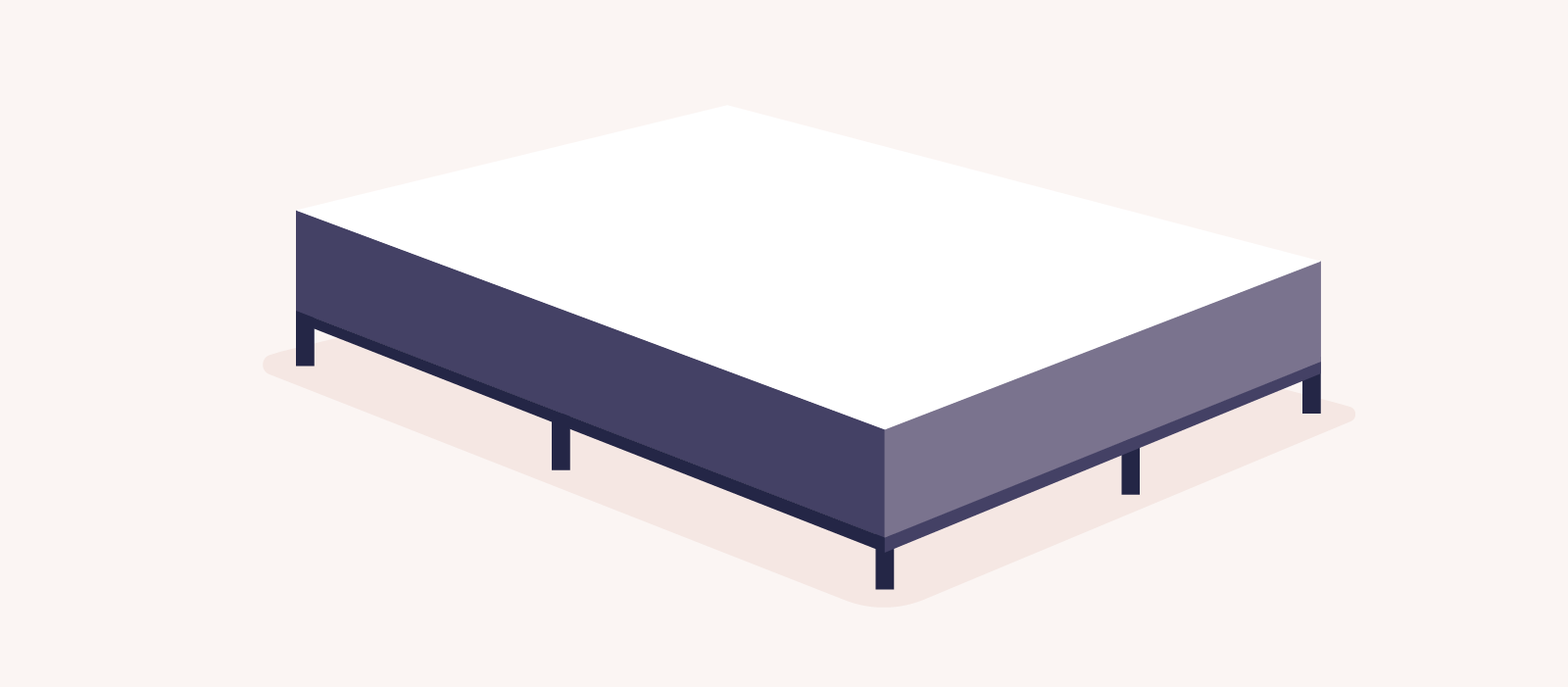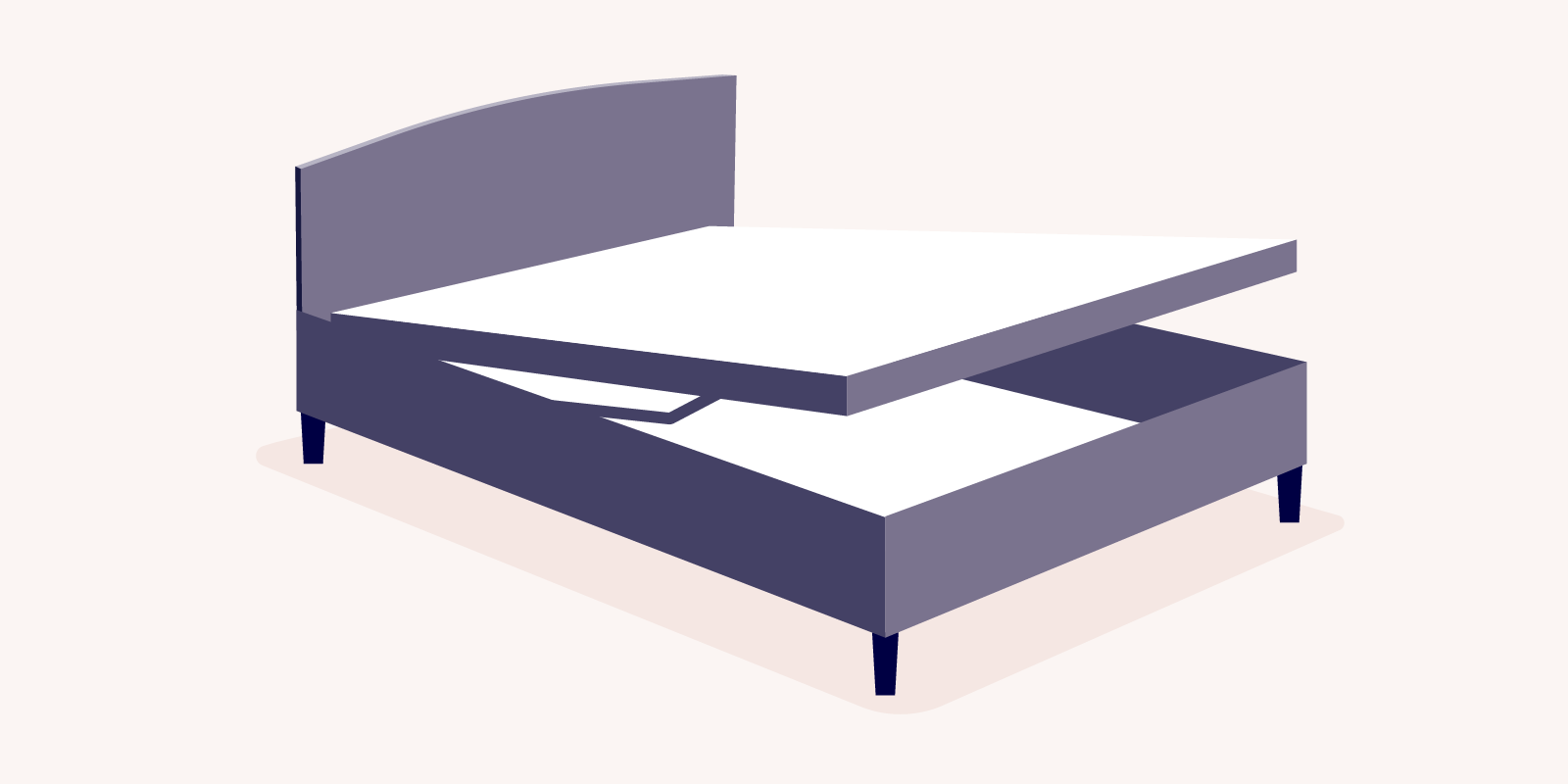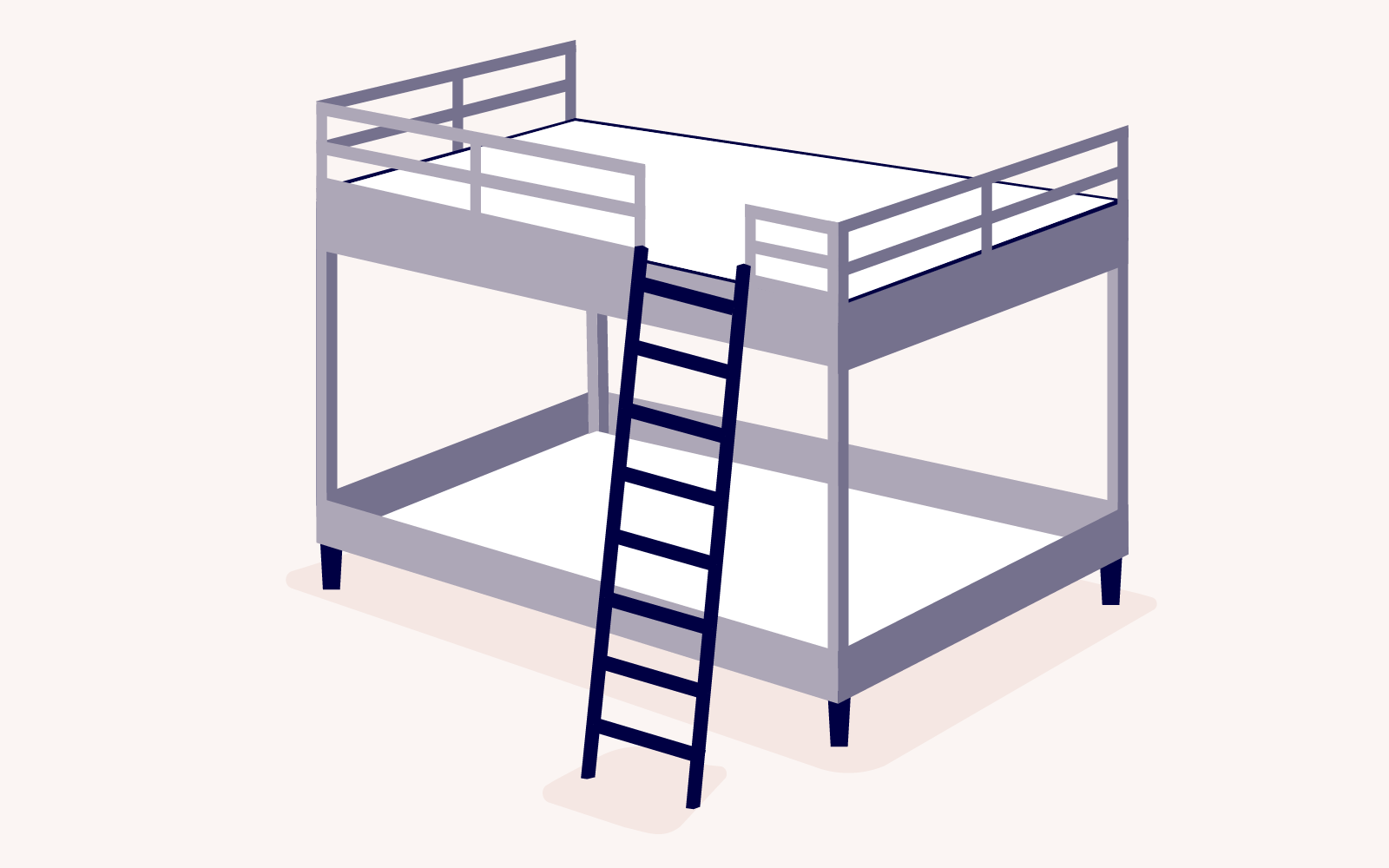A bed frame is a piece of furniture that supports your mattress and elevates it off the ground. Essentially, adding a bed frame to your mattress is what truly gives you a bed. Frames range in design from minimalist and functional to decorative and stylish, giving you plenty of options for customizing your sleeping space.
Types of Bed Frames: Which Style Is Right For You? (2025)
Updated: March 31, 2025 | Published: July 2, 2024Your bed frame provides a foundation for your mattress, giving it support and stability. It also adds style to your bedroom and makes a statement about who you are.
With so many options to choose from, it can be hard to know which type of bed frame is right for you. Not to worry—we’ll explore various types of bed frames, along with their pros and cons, to help you make an informed decision.
Adjustable Bed Frame

An adjustable bed frame lets you elevate the bed’s head and foot to your comfort level. These motorized frames are ideal if you need to sleep in a specific position. They also come in handy for reading, watching TV, and relaxing in bed.
Some adjustable bed frames, like the Douglas Adjustable Bed, have split king models that let you adjust elevation on either side of the bed. The Douglas Adjustable Bed also includes zero-G and massage modes, a wireless remote for hassle-free control, and a full range of adjustability.
Pros: Customizable positioning; good for watching TV or reading before sleeping; reported to help with conditions like snoring and sleep apnea.
Cons: Only compatible with certain types of mattresses; requires access to an electrical outlet
Platform Bed Frame

Platform bed frames combine a foundation with a metal frame beneath. This type of bed frame often has a low-profile design and blends in with the mattress and bedding.
Platform bed frames usually have four legs in each corner. However, some may feature more legs to accommodate larger, heavier mattresses. Some platform beds can also have additional features like upholstered sides, wooden slats, and removable legs.
Pros: Eliminates the need for a box spring; can be more affordable than other bed frame types
Cons: May be too low to the ground; might make thinner mattresses feel too firm
Divan Bed Frame

Divans offer extra storage space by turning the base of your bed into a practical solution for storing items.
Some divan bases are completely hollow, allowing you to slide objects in and out freely. Others feature pull-out drawers, which may be located somewhere at the footboard, along the sides, or both.
Divan bases may or may not be upholstered to match the colour of your mattress and bedding. However, unlike other types of storage bed frames, divans don’t have a headboard. This makes the frame more compact and helps it fit easily into smaller spaces.
Pros: Stylish and comfortable; great for storage in small bedrooms
Cons: Can be pricier than some other bed frame types; may be bulky and hard to move
Sleigh Bed Frame

Sleigh bed frames have a curved headboard and footboard, which makes them look like a traditional horse-drawn sleigh.
This design is a popular choice for many shoppers looking to create a classic, formally styled bedroom. It’s often larger than other bed frame styles, so it can provide a focal point for the room.
Pros: Adds visual interest to the bedroom; available in various material types and finishes
Cons: Can be prone to wear and tear if made from wood; design can be bulky and heavy; often leaves limited space under bed for storage
Upholstered Bed Frame

Upholstered bed frames feature a padded headboard, and often include a similarly padded footboard. They add a simple but tasteful aesthetic touch to your bedroom, and make it more comfortable for you to sit up in bed.
Pros: Provides added comfort for sitting up in bed; available in a wide range of materials and colours
Cons: Upholstery can be hard to clean; can be more expensive than other styles of bed frames
Wrought-Iron Bed Frame

Wrought-iron bed frames feature intricate metalwork designs, adding a touch of elegance and vintage charm to your bedroom. These frames are durable and long-lasting, making them a timeless choice for various design styles ranging from farmhouse to contemporary.
Despite the name, many modern metal bed frames aren’t actually made of iron. The name refers to the style rather than the material. This type of bed frame is often made of powder-coated steel.
Pros: Durable and long-lasting construction; available in a variety of simple and ornate designs
Cons: Heavier and more difficult to move than other types of bed frames
Spindle Bed Frame

Spindle bed frames feature evenly spaced vertical spindles on the headboard and/or the footboard. These frames are often made out of wood but can be made using other materials. They’re a good choice for adding a simple aesthetic touch to your bedroom.
Pros: Simple enough to suit various bedroom styles; usually provides good mattress support
Cons: Spindles can be hard to dust/clean; spindle height/design might make frame bulky and difficult to move
Poster Bed Frame

Poster bed frames add style and grandeur to any bedroom. They’re instantly recognizable by the tall posts at each corner of the bed, sometimes with connecting rails for a fabric curtain canopy. This type of bed frame works best in a room with higher ceilings.
Pros: Adds a hefty dose of style to your bedroom; offers versatility for hanging curtains or drapes
Cons: Requires a tall room with space to accommodate bedposts; tend to be more expensive than other options
Canopy Bed Frame

Similar to poster beds, canopy bed frames feature four tall posts at each corner. The difference is that the posters on a canopy bed are connected to each other, creating a frame-like enclosure.
Canopy bed frames may have more elegant designs resembling classic poster beds, but more modern designs often use thin rails for a more minimalist feel.
The curtains provide an additional layer of privacy if you want it. They can also help you stay warm by retaining heat closer to your bed. In warmer climates, this type of bed frame is common for keeping out insects.
Pros: Adds visual interest to your bedroom; curtain canopy provides additional privacy
Cons: Requires a larger room with space to accommodate canopy frame; can be more expensive than other options; can be difficult to keep clean
Ottoman Bed Frame

Ottoman bed frames have a hinged, hollow base that lets you lift up your mattress, turning your sleeping space into storage. These frames are ideal if you have a small bedroom, need extra storage, or just need furniture that helps cut down on clutter.
Pros: Provides hidden and convenient storage; makes efficient use of space
Cons: Limited weight capacity for lifting mechanism; may take extra effort to lift/close the base
Storage Bed Frame

Storage bed frames use built-in shelves or drawers to store your bedding, clothing, or other items. Some headboards also come with extra shelving for even more storage space.
These frames are practical and functional, offering both support and storage in a single piece of furniture. They work well in smaller rooms, but you’ll need enough space on either side to open the drawers.
Pros: Provides convenient storage; makes efficient use of space
Cons: May be more expensive than other options; heavy and difficult to move
Murphy Bed Frame

Also known as wall bed frames, Murphy bed frames fold up into your wall or a built-in cabinet when not in use. Many also come with additional built-in storage.
A Murphy bed is a good choice for small bedrooms, studio apartments, and other open layouts with minimal square footage. It also helps free up your bedroom floor for other activities.
Pros: Maximizes space in small apartments or multi-functional rooms; works well as your regular bed or a guest bed
Cons: Requires professional installation for wall-mounted models; may be more expensive than other options
Futon Bed Frame

Futon bed frames have a convertible design that allows them to turn from a sofa into a bed, usually by lowering the back of the couch.
Futons are a good choice if your living space is relatively small, or you’re looking for a sleeping option in a multi-function room. These frames are also known for being budget-friendly.
Pros: Multi-functional use; ideal for small spaces or guest accommodations; more affordable than traditional sofa beds
Cons: Thinner mattress may not be as comfortable long-term; limited variety in design options
Bunk Bed Frame

Bunk bed frames stack two or more beds vertically, connected by posts. The top bed often has a guard rail around the edges and is usually reached with some form of ladder.
A bunk bed is a common space-saving option that works well for children’s rooms or guest rooms. These frames are practical, usually inexpensive, and available in a wide variety of materials.
Pros: Efficient use of vertical space; gives you sleeping arrangements for two or more people
Cons: Upper bunk may not be accessible to people with mobility issues; limited headroom in lower bunk; requires two or more mattresses plus bedding
Loft Bed Frame

Loft bed frames provide a raised sleeping platform with open space underneath. This extra space can be used for a desk, storage, seating area, or other activities.
A loft bed frame is an excellent choice for maximizing space in a small bedroom. This style of bed frame is available in most standard mattress sizes.
Pros: Provides room for desk, storage, or seating underneath; ideal for children, teens, and single adults
Cons: May not be accessible to people with mobility issues; requires a ladder or stairs for access to the bed; limited headroom in under-bed loft
Daybed Frame

Daybed frames have a sofa-like design. The mattress that can be used as both a bed and a seating area during waking hours—the reason for the “day” in “daybed.”
These frames are versatile and functional. Daybeds come in a variety of designs, and some options have additional storage drawers beneath. This frame size usually fits a twin-size mattress.
Pros: Doubles as a sofa and bed; good choice for your guest room, living room, or home office
Cons: Limited sleeping space for larger or taller people; may need additional pillows for back support when used as a couch
Trundle Bed Frame

Trundle bed frames look like a single bed at first glance. However, a hidden second mattress slides out from underneath the main bed frame, giving you two beds in one.
A trundle bed provides extra sleeping space for guests, or for children who share a room. These frames often have wheels that make it easier to pull out the extra bed and store it after use.
Pros: The second bed slides away to provide extra storage space; design is more discreet and compact than other multi-bed frames
Cons: Lower bed often requires a thinner mattress; limited weight capacity on lower bed; can be difficult to move around the room when the lower bed is out
Pull-Out Sofa

Pull-out sofa bed frames function as a sofa during the day. But when bedtime arrives, you can simply remove the sofa cushions and pull out a hidden mattress from inside the frame.
Pull-out sofas are a common choice for people with occasional guests. They’re also a good fit for studio apartments and other multi-use spaces that need to double as a bedroom.
Pros: Two-in-one sitting/sleeping solution; optional sleeping space for guests
Cons: Might not be as comfortable as a typical mattress; mattress might not last as long due to thinner design; exceptionally heavy and difficult to move; limited mattress replacement options
FAQ
The cost of a bed frame can vary depending on size, features, quality, and where you buy. Prices range from budget-friendly to high-end options. For example, you could spend $250 on a simple platform bed or futon, while a sleigh bed or sofa bed could cost well over $2,000.
The best bed frame is the one that fits your design tastes, sleep needs, and budget. That said, avoid bed frames that use thin wire or thin slats. Frames using these elements often provide insufficient or uneven support for larger or heavier mattresses. This can damage your mattress as you’re lying on it.
Bed-in-a-box mattresses especially require support across the entire bottom surface. If you’re shopping for a bed-in-a-box mattress like Douglas or Logan & Cove, make sure your bed frame is compatible before you buy.
Not all bed frames require a box spring. Some mattresses are designed to support a mattress directly. However, it’s a good idea to check the manufacturer’s recommendations for your specific bed frame before you buy a new mattress.
READ MORE: Do you need a boxspring?
Keep these factors in mind when you’re shopping for a bed frame:
- Your budget
- The size and height of your mattress
- How high off the floor you want your bed to be
- The relative size of your bedroom
- What features and accessories you want
The specific type of mattress you have is also important. Some bed bases work better with certain types of mattresses.
For example, you’ll have a hard time fitting a thicker mattress onto the lower part of a trundle bed. You also won’t want to place a heavy mattress on top of an ottoman frame, since that’ll make it harder to lift.
That depends on the kid, their age, their bedroom, and their specific needs. For example, two older kids may do well with a bunk bed, but it may not be the right fit for a younger child who could fall off the top bunk. Or, if the child has a small room and needs extra storage, a divan could be right for them.
Whatever you choose, check the bed frame for possible safety issues, especially with an elevated bed.
That depends on the mattress (and the couple). Couples usually sleep on larger mattresses, so a queen or king-size bed frame that matches a couple’s specific needs is best. Keep in mind that some bed frame styles, like futons and daybeds, may not be available in the larger sizes that many couples prefer.
Our goal is to provide the information you need to find the mattress that’s right for you. Get started with some of our most popular mattress shopping resources:
- Best Mattress Guides: Best Mattress Canada, Best Mattress In a Box
- Reviews: Douglas Original, Logan & Cove Choice, Juno, Octave Vista
- Comparisons: Douglas vs Endy, Douglas vs Casper
We use independent, third-party engineering firms (commissioned by us) with the APEGA stamp of approval to conduct mattress testing on our behalf, using publicly available data. We review and test all mattresses on 40+ criteria we think are important to you, including price, country of manufacture, sleep trial, warranty, features, materials used, motion isolation and edge support ratings, customer satisfaction reviews, returns, and refunds.
